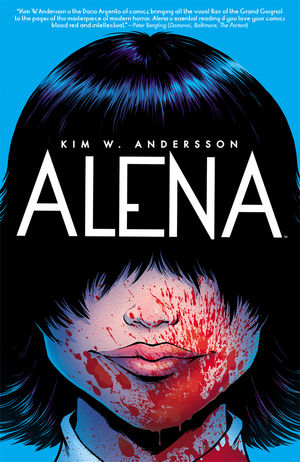Review: Alena
Why do the Swedes seem to love stories about darkness and alienation so much? As an American, I’m hardly in a good position to throw stones or criticize anybody else, and I personally am drawn to melancholic and dark stories. This blows the doors off of that, though. Alena is a dark look at teenaged life, with a girl being alternatively protected and haunted by her dead best friend and lover.
It’s been a year since Alena’s best friend Josephine took her own life, leaving Alena alone. Victimized by bullies at school, in particular by a girl named Philippa, the ghost of Josephine is giving Alena advice on how to stand up to them. Yet Josephine’s motives are far from pure, and when Alena starts to get too close to somebody else, she starts lashing out at him as well. Alena is caught in the middle of this, trying to protect herself and deal with her grief from Josephine’s death.
The art has a willfully grotesque character to it. Not grotesque in the typical comic book sense, with violence and blood splatters, but in people’s facial expressions. At first, I thought that they were mistakes or little flubs because some of the characters take on such unnatural expressions, but I realized I was wrong after a while. Remember all of the ugly sneers you saw when you’re in high school? They’re all here, and it’s like they’re under a magnifying glass. They’re exaggerated to an almost horrifying degree, page after page of cruelly leering faces.

It’s tempting to compare this to Let The Right One In (in part because my knowledge of Swedish films and literature consists of Bergman, Stieg Larsson, and the Wallander series), and there are some familiar beats there. If we accept that Josephine is a ghost, she fills the same role that Eli did in that other story: a friend, but an ambiguous one, pulling the other toward a darker place. Their protection comes the only way that they know how, which is destructive.
But I think this story should stand apart from its admittedly excellent counterpart, in part because of the subtlety in the horror narrative. Like The Shining, we’re never given a real clue whether what Alena is experiencing is the supernatural or just madness. Every time Josephine strikes, it could just as easily be Alena; there isn’t a moment where it’s indisputably Josephine doing anything. Indeed, I walked away from the book thinking that madness was the better explanation because this is a story where guilt is at the root of Alena’s psyche. She wronged her friend, and now her friend seems to be showing up as a nagging reminder of both how strong Josephine was, but also how destructively attached she was to Alena.
Coming back to the art, that’s the other level at which it works so well. People in the midst of a psychotic break occasionally feel like everybody is out to get them, or that the people around them are suddenly sinister and unfamiliar. The only time that the art isn’t conveying that is when Alena is flashing back to her and Josephine on the bridge. It makes madness seem more plausible
It would be easy to just dismiss Philippa’s arc as ego and vanity, but there are at least a couple of hints that it’s more complicated than it initially suggests. Philippa seems to be experiencing her own narcissistic and paranoid delusions; why does she interpret the boots as such a grave insult? Why does she lie about the Paris trip, which was obviously much, much worse than she makes it out to be? It was interesting to suggest that three of the characters, Philippa, Alena, and Josephine, all are violent, territorial, and paranoid about other people. Are Josephine and Philippa all that different? Both lose somebody and start lashing out violently.
I will say that the story left one thread dangling that was never resolved in a satisfying way. The school guidance counselor is important for the first half or two-thirds of the story but then disappears, not even reappearing for the dramatic conclusion. I couldn’t say what her purpose in the story was because we don’t learn much about Alena when she talks to her. At best, she’s a symbol of how ineffective adults are when trying to deal with how cruel teenagers are, but that was no reason to omit her at the end.
This is a violent and uncomfortable story, one that I’m not sure I’d want to pick up again because its depiction of teenage life is so uncomfortable. But it’s still a good and compellingly dark read. It’s clever and nuanced, and even if you can only read it once because it’s so disturbing, you should do it.
[su_box title="Score: 5/5" style="glass" box_color="#8955ab" radius="6"]
Alena Writer/Artist: Kim W. Andersson Publisher: Dark Horse Comics Price: $17.99 Format: TPB; Print/Digital
[/su_box]
